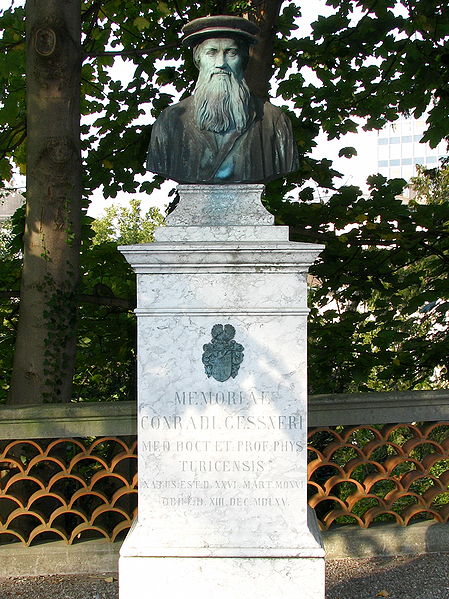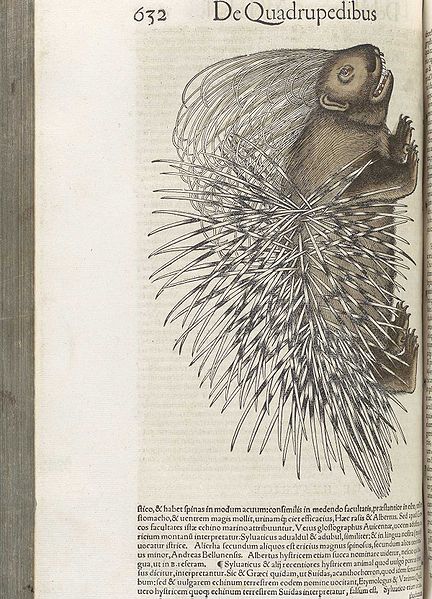<Back to Index>
- Naturalist Konrad Gessner, 1516
- Writer Louise Otto Peters (Otto Stern), 1819
- King of Egypt Fuad I, 1868
PAGE SPONSOR
ΕΚΛΟΓΕΣ 2012
Τυπώστε και Ψηφίστε



Konrad Gessner (Conrad Gessner, Conrad Geßner, Conrad von Gesner, Conradus Gesnerus, Conrad Gesner; 26 March 1516 – 13 December 1565) was a Swiss naturalist and bibliographer. His five volume Historiae animalium (1551 - 1558) is considered the beginning of modern zoology, and the flowering plant genus Gesneria (Gesneriaceae) is named after him. This botanist is denoted by the author abbreviation Gesner when citing a botanical name.
Born and educated in Zürich, he was the son of a furrier. After the death of his father at the Battle of Kappel (1531), he was very short of money. He had good friends, however, in his old master, Oswald Myconius, and subsequently in Heinrich Bullinger, and he was enabled to continue his studies at the universities of Strassburg and Bourges (1532 - 1533); in Paris, he found a generous patron in the person of Job Steiger of Berne.
In 1535, religious unrest drove him back to Zürich, where he made an imprudent marriage. His friends again came to his aid, enabled him to study at Basel (1536), and in 1537 obtained for him the professorship of Greek at the newly founded academy of Lausanne (then belonging to Berne). Here he had leisure to devote himself to scientific studies, especially botany. In 1540 - 1541 he visited the famous medical university of Montpellier, took his degree of doctor of medicine (1541) at Basel, and then settled down to practise at Zürich, where he obtained the post of lecturer in physics at the Carolinum, the precursor of the University of Zürich. There, apart from a few journeys to foreign countries, and annual summer botanical journeys in his native land, he passed the remainder of his life. He devoted himself to preparing works on many subjects of different sorts. He died of the plague, the year after his ennoblement.
To
his contemporaries he was best known as a botanist, though his
botanical manuscripts were not published till long after his death (at Nuremberg, 1751 - 1771, 2 vols. folio), he himself issuing only the Enchiridion historiae plantarum (1541) and the Catalogus plantarum (1542) in four languages. In 1545 he published his remarkable Bibliotheca universalis (ed. by J. Simler, 1574), supposedly a catalogue (in Latin, Greek and Hebrew) of all writers who had ever lived, with the titles of their works, etc. A second part, Pandectarum sive partitionum universalium libri xxi,
appeared in 1548; only nineteen books being then concluded. The last, a
theological encyclopaedia, was published in 1549, but the last but one,
intended to include his medical work, was never finished.
His great zoological work, Historiae animalium, appeared in 4 vols. (quadrupeds, birds, fishes) folio, 1551 - 1558, at Zürich, a fifth (snakes) being issued in 1587 (there is a German translation, entitled Thierbuch, of the first 4 vols., Zürich, 1563): this work is the starting point of modern zoology. Not content with such vast works, Gessner put forth in 1555 his book entitled Mithridates de differentis linguis, an account of about 130 known languages, with the Lord's Prayer in twenty-two languages, while in 1556 appeared his edition of the works of Claudius Aelianus. It includes sketches for many well known animals, and some fictional ones, including unicorns and mermaids.
To non-scientific readers, Gessner is best known for his love of mountains (below
the snow-line) and for his many excursions among them, undertaken
partly as a botanist, but also for the sake of exercise and enjoyment
of the beauties of nature. In 1541 he prefixed to his Libellus de lacte et operibus lactariis a letter addressed to his friend, J. Vogel, of Glarus,
as to the wonders to be found among the mountains, declaring his love
for them, and his firm resolve to climb at least one mountain every
year, not only to collect flowers, but in order to exercise his body.
In 1555 Gessner issued his narrative (Descriptio Montis Fracti sive Montis Pilati) of his excursion to the Gnepfstein (1920 m), the lowest point in the Pilatus chain.
Gessner was the first to describe the brown rat in Europe. Gessner was the first to document the pencil in 1565. Gessner was featured on the 50 Swiss francs banknotes issued between 1978 and 1994. Gessner was partly responsible for Insectorum, sive, Minimorum animalium theatrum or Theatre of Insects, This work was written jointly by Gessner (posthumously) , Edward Wotton, Thomas Muffet and Thomas Penny. Gessner in 1551 was the first to describe adipose tissue. Among his friends was John Caius, court physician to the Tudors and second founder of Gonville and Caius College, Cambridge.